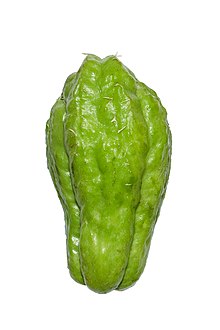Chayote
| Chayote | |
|---|---|
 |
|
| Chayote fruit | |
 |
|
| Chayote fruit cross section | |
| Scientific classification | |
| Kingdom: | Plantae |
| (unranked): | Angiosperms |
| (unranked): | Eudicots |
| (unranked): | Rosids |
| Order: | Cucurbitales |
| Family: | Cucurbitaceae |
| Genus: | Sechium |
| Species: | S. edule |
| Binomial name | |
|
Sechium edule (Jacq.) Sw. |
|
| Synonyms | |
| Nutritional value per 100 g (3.5 oz) | |
|---|---|
| Energy | 80 kJ (19 kcal) |
|
4.51 g
|
|
| Sugars | 1.66 g |
| Dietary fiber | 1.7 g |
|
0.13 g
|
|
|
0.82 g
|
|
| Vitamins | |
| Thiamine (B1) |
(2%)
0.025 mg |
| Riboflavin (B2) |
(2%)
0.029 mg |
| Niacin (B3) |
(3%)
0.47 mg |
| Pantothenic acid (B5) |
(5%)
0.249 mg |
| Vitamin B6 |
(6%)
0.076 mg |
| Folate (B9) |
(23%)
93 μg |
| Vitamin C |
(9%)
7.7 mg |
| Vitamin E |
(1%)
0.12 mg |
| Vitamin K |
(4%)
4.1 μg |
| Minerals | |
| Calcium |
(2%)
17 mg |
| Iron |
(3%)
0.34 mg |
| Magnesium |
(3%)
12 mg |
| Phosphorus |
(3%)
18 mg |
| Potassium |
(3%)
125 mg |
| Zinc |
(8%)
0.74 mg |
|
|
|
|
|
| Percentages are roughly approximated using US recommendations for adults. Source: USDA Nutrient Database |
|
Chayote (Sechium edule) is an edible plant belonging to the gourd family Cucurbitaceae, along with melons, cucumbers and squash. Globally it is known by many names including christophene or christophine,cho-cho,cidra (Antioquia, Caldas, Quindio and Risaralda regions of Colombia), sayóte (Filipino languages), guatila (Boyacá and Valle del Cauca regions of Colombia), centinarja (Malta), sousou or chou-chou (chow-chow) (Mauritian Creole), sousout (Seychellois Creole), chuchu (Brazil), caiota (Azores), pimpinela (Madeira), pipinola (Hawaii), tayota (Dominican Republic), mirliton (Haitian Creole), pear squash, vegetable pear,chouchoute (Vanuatu), choko (Australia), güisquil (Guatemala, El Salvador), pataste (Honduras), piskot or sikot (Meghalaya), is-kus (Nagaland), dashkush (Manipur), iskut (Mizoram), is-Kush (Nepal) su su (Vietnam). Its tuberous and edible root is called chinchayote or chayotextle in Mexico and ichintal or güisquil in Guatemala.
Chayote is originally native to Mesoamerica. It has been introduced as a crop worldwide. The main growing regions are Brazil, Costa Rica, Veracruz, Mexico and Abkhazia. Costa Rican chayotes are predominantly exported to the European Union, whereas Veracruz mainly exports its chayotes to the United States.
...
Wikipedia
